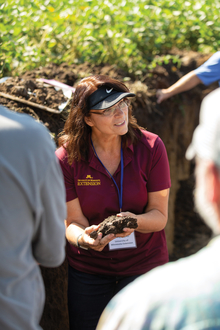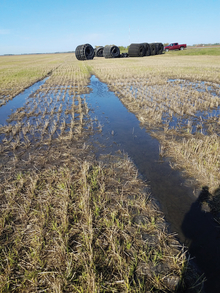We all want and need clean water—Minnesota farmers are learning the role healthy soil plays.
The view from the road must have seemed odd—the only thing visible was a cluster of white tents, a University of Minnesota Extension field day flag, and occasionally the top of a ball cap.
Each year, farmers and other soil health practitioners gather in a farm field to look below ground—several feet below ground. The name of the 2019 event? Life in the Pits.
The “pits,” are the deep trenches where participants can see and touch layers of soil and all its elements. “Life” refers not only to the people in the pits having a lively exchange of ideas but to the soil itself. A healthy soil is a living soil, one that has a diverse community of organisms living inside it, a structure to allow air and water movement, and the ability to cycle nutrients to plants.
After a day viewing such life underfoot, one might never again call it “dirt.”
“About seven years ago I started to get more questions about all kinds of practices that can make soil healthier,” says Jodi DeJong-Hughes, Extension educator. “Healthier soils act like a sponge, holding water for crops to use. Without this, rainfall can carry soil and plant nutrients downstream, reducing water quality in our streams, rivers, and lakes.”
Crop consultants play key role
“Any time water is moving, it’s taking something with it,” says Dorian Gatchell, agronomy consultant and owner of Minnesota Agricultural Services in Granite Falls. Gatchell has attended, and even helped plan, some of the many soil education events put on each year by Extension. “I’m able to bring questions my customers ask to Extension and University researchers. Our relationship is good for my business,” he says.
DeJong-Hughes has lots of “tools in the toolbox” for Gatchell and his customers. Some involve options for how they till the soil. Others are about planting alternative “cover crops” that keep roots in the ground in between regular crop seasons to prevent weeds and erosion. “Conserving soil and water can even pay off economically, as well as for the environment,” says DeJong-Hughes.
Soil standards on the way
Anna Cates, Minnesota’s first state soil health specialist, is on a mission to standardize soil health measures for the northern Midwest. As an Extension soil scientist in the Minnesota Office for Soil Health, a collaborative initiative between the Minnesota Board of Water and Soil Resources and the University of Minnesota Water Resources Center, Cates collaborates with state agencies, local individuals and University researchers.
Last fall, Cates and Hava Blair, University of Minnesota Ph.D. candidate, completed the first year of a two-year soil sampling effort. “This project is not just about science. We work directly with people on their farms, so communication is very important,” says Cates.
It’s been a statewide learning and leadership experience for Blair. “Anna and I worked closely with several organizations to identify 26 farmers in four regions representing diverse ecology, soil, growing conditions and farming practices,” she says.
The U’s Minnesota Supercomputing Institute will build a new soil health database to share findings. Cates and Blair will also share the information at field days and in a final report.
Farmers want hard data
Holly Hatlewick, Soil, Water Conservation District administrator in Renville County, feels most comfortable when she is out in a crop field with a farmer.
“I’m not going to sell soil health by myself, but farmers will listen to other farmers,” says Hatlewick. Extension, the Soil and Water Conservation Districts, and the new farmer-led Minnesota Soil Health Coalition try to make space for farmers to mentor other farmers. That’s why it’s important that people like Gatchell are involved. Gatchell is not only an ag consultant but a fifth-generation farmer. Hatlewick and Gatchell agree that farmers want to see numbers behind new practices. “Research is what starts the conversation,” she says.
Lindsay Pease takes Red River Valley farmers on a drainage research journey
Extension is helping farmers in the northwest Red River Valley decide whether drainage system investments are right for their farms.
Lindsay Pease, Extension nutrient management specialist, designed and installed a new subsurface drainage system at the Northwest Research and Outreach Center in Crookston with the help of Ellingson Companies. She divided 60 acres into four 15-acre plots—two drained and two undrained—and will monitor crop yield to calculate the return on investment. She will also study strategies to keep crop fertilizer nutrients out of our waters while maintaining a profitable operation.
“I will be taking northwest Minnesota farmers on this journey with me as I evaluate my investment,” says Pease, who will present research updates at events across the state. Keep track of the project by following @LPeaseUMN and @UMNNutrientMgmt on Twitter, and @UMNNutrientMgmt on Facebook and subscribe to Minnesota Crop News.






